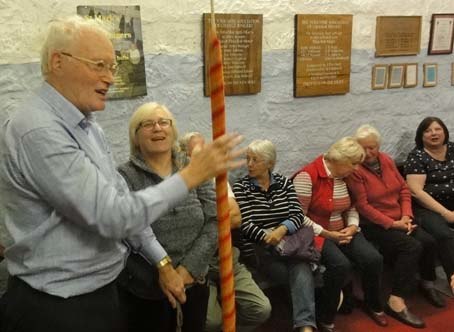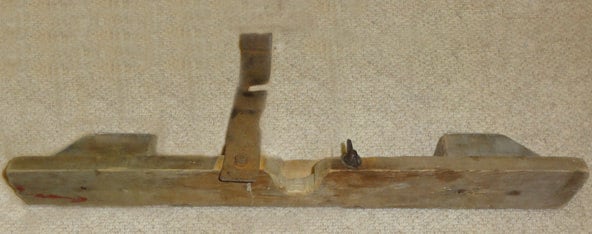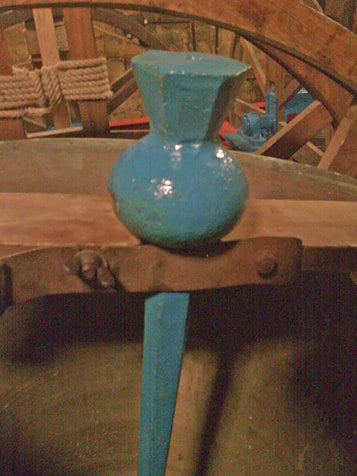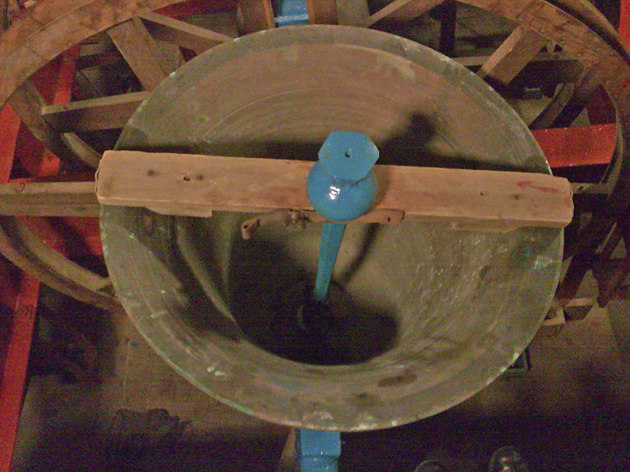-
A commercial Bellringing "experience"During the WI's Centenary Year (2015?) our local WI had added 'Discovering Bell Ringing' to their list of '100 things to do in the Centenary Year and they arranged for a party of about 20 a visit to the tower.
To explain what was 'upstairs' we projected a 3-4 minute Powerpoint show on to a whitewashed wall. It showed photos of the bells, the clock room and the views from the tower roof and recycled every 4-5 minutes throughout the evening.
As an opening demo' we rang r&cc and plain hunted on 6 with simple explanations - sufficient to demonstrate the principle of change ringing. Our two tutors ensured that every visitor had an opportunity to ring some assisted backstrokes and those who showed some proficiency with the basics of rope-handling were offered the opportunity to ring assisted backstrokes in rounds on six bells. I think we rounded off the evening with a course of Stedman Triples as a closing demo. We didn't expect to draw any recruits from this group but they all enjoyed the experience and afterwards their organiser sent a very appreciative letter.

WI visit to Marske-by-the-sea (8, 6-3-21) -
What activty was successful in raising awareness of ringing in your community?We are blessed with easy access to the bell chamber, the clock chamber and the tower roof. Once a year, in the summer months, we hold a tower Open Day and allow visitors to see the bells, clock and to take photos over the roof tops of the town from the tower roof.
We place ringers as Rooom Stewards at every level of the tower to watch over the visitors and to provide explanations. Depending on the number of visitors and the number of ringers on hand we include one or two ringing demos. We also have a 7 minute Ppt slide show that loops round continuously onto the white walls of the Ringing Room. We will double muffle one bell and encourage visitors to try a few assisted backstrokes.
Our most successful day attracted over 140 visitors. We control the flow of visitors going up to the bells and on to the roof. Curiously the last time we did it, one more visitor came down from the roof than we had allowed to go up! -
The future of peal ringingIt's not just the decline in peal ringing we should be concerned about. There has been a gneral decline in the frequency of meetings and the interchange of ringers between neighbouring towers.
Some old diaries from the 1970s came to light following our recent house move. Flipping through the pages, I was surprised at how much ringing I was doing then - regularly out almost every night of the week and frequently travelling up to 120 miles (there & back) to attend a local branch meeting in the extremeties of the branch. Mind you I was then in my 30s so perhaps it was down to youthful enthusiasm! Nevertheless, branch meetings which used to be a montlhy event are less frequent now and sadly my peal-ringing days are well behind me now. -
VentilationAll very valid points but in this particular location, the clock room had a locked door to prevent unauthorised access. I can't quote the dimensions of the spaces in the corners of the trapdoor, but they were effective ventilators and also enabled us to hear the bells more clearly. I should add perhaps that this was quite a long time ago, before the man from Health & Safety was even born!
The trap was closed some years later when the the ingress of birds transformed it into an avian hotel and the clock engineers declined to service the clock due to the state of the clock room and bell chamber. -
VentilationA tower near us has dome the same. Their ringing room is quite small, perhaps only nine feet square with an eight foot high ceiling and entrance is through a trapdoor in the floor. A sturdy metal grill about 18inches square in the corner of the room allows fresh air to rise into the room and it is covered with a carpet sample square.
Another tower in the vicinity has a large bell-sized trapdoor in the ringing room ceiling, forming the floor of the clock chamber. For many years this was lifted and rotated a few degrees creating wedge-shaped holes in the corners, sufficient to aid ventilation but much too small to be a hazard. -
VentilationWe have a 24" wide (approx) wall mounted heater over the door. It is mounted on brackets which enable us to tilt the fan up and down. In winter (and chilly days) we tilt it down to make a warm air 'curtain' over the door; on days when the ringing room gets a bit stuffy, we turn off the heating elements and tilt it up, to blow cool (unheated) air horizontally over the heads of the ringers.
(I was intending to include a photo but I can't remember / find out how to paste an image into a message! How or where do I find or create a link to an image in my Picture Folder?) -
Costs of learning to ringTwo adult beginners were quite surprised when they were told that training in bell ringing was free. The implication of their comments was that paid-for courses have a value or perhaps more value than something that is free. Either way, they are both making steady progress and are valued members of our team.
-
Some advice and ideas pleaseYes, you are of course quite correct. You know that and I know that, but I doubt any learners have ever considered the point! Over the years, when learners first start ringing both strokes (with assistance), I have noticed that at the bottom of the backstroke their hands tend to dwell in front of their lap, as they will have been told when starting to ring backtroke only.
The idea of using an example of speed differential is to encourage them to move their hands quickly upwards to catch the sally. It seems to work! -
Some advice and ideas pleaseI tend to agree with other comments - the younger ringer's problem goes right back to basics. When I see that a learner is not pulling right through at backstroke, I will rest the first two fingers of one of of my hands on top of his hand and gently apply pressure to continue the downward movement until the backstroke is completed and his hands are down by his lap.
I also remind the learner that the bellrope does not come down at a constant speed but accelerates as the bell swings down towards bottom-dead-centre and slows as it swings up to the 'UP' or set position. We often describe the speed of the ringer's arm movement as 'pulling down at 30mph and then the hands rising up at 40mph to catch the sally'.
It is also important to adjust the rope length so that the learner's arms are at a comfortable full-stretch when the bell is at backstroke. Hence they must straighten their arms at backstroke and cannot control the bell with elbows bent at 90º. Then when introducing the handstroke start by having them reach as high up the sally as they can with arms comfortably fully stretched, this is the 'target' position for catching the sally. If necessary use a rubber band or a loop of string to mark this 'target' position on the sally. Caveat - use this only briefly so that it doesn't lead to them always watching the sally rise and fall - a chronic bad habit that is difficult to break!
Regarding the lady who struggles with plain hunting: a useful exercise might be to ring only two bells and have the learner following a competent ringer. The object is for your learner to keep in step with the other ringer. Ring 'rounds' on the two until the rhythm setttles, then have the other ringer ring 5 or 6* deliberately slow blows as if hunting up, followed by 5 or 6 quicker blows to represent hunting down. You can insert a few blows at 'standard' rounds speed between the hunting-up set and the hunting-down set if it helps. This should help to give the learner the confidence to adjust the speed of her ringing.
(* Depending on whether you practice Doubles or Minor. Personally I prefer to always use 6 blows as the even number seems to make it easier for the learner to 'change gear'.) -
Plump SalliesThe plump-nosity of a sally seems to be related directly to the manufacturer's quality control and rope specification. Our original ropes made in 1972 by the late Peter Minchin have retained their plumpness rather better and are still wearing better than a spare set that we bought from another supplier about a decade ago. I guess the shape and firmness of the sally is determined by the density of the wool spun into the rope.
-
Cleaning bellropesPerhaps you have hit on a potential commercial opportunity for some entreprenurial TC or steeple-keeper. Where & when does the research begin?
-
Cleaning bellropes["they became too stiff to use."[/quote]
. . . ah, that would have been in the days before 'fabric softeners' ;-) -
Cleaning bellropesI would add a cautionary note on the potential perils of rope-cleaning. Many years ago, we rescued a set of old but re-usable ropes from a dusty belfry. Without giving any thought to the probable outcome, one of the ladies in the group dumped them in her washing machine. THIS IS DEFINITELY NOT AN OPTION! The result was a set of soft limp ropes that stretched like bungee ropes - and the sally colours merged into one another. They were hung with weights for several months as we tried to eradicate the stretch.
On a subsequent occasion we patiently scrubbed the sallies and the grubbiest part of the tail end with minimal amounts of soapy water and a nail brush. It was tedious but worth the effort. -
Ringing 2030 - stillborn?What is actually happening 'on the ground' in respect of this 'Ringing 2030' scheme? I see it mentioned in this forum from time to time but that's all. I have seen and heard nothing at the local towers where I help and tower leaders seem to be unaware of the scheme.
-
Height of salliesI don't rcall polyester being widely available in 1970 when we bought the ropes for our new bells. We have since had all the top ends (from 1 metre above the sallies) replaced with polyester on our spare set and are gradually introducing them as the old ones are replaced.
-
Height of salliesWhen fitting new ropes, I set them so that the elusive 'average' ringer catches the sally about two-thirds of the way up the sally. Then as the ropes start to wear over the months at the garterhole, I can draw the weakened section of rope an inch or so inside the garter hole so that is is no longer flexed at every stroke. We are still using the ropes (by Peter MInchin) bought when the bells were installed in 1972 - that's 52 years of weekly service ringing and practice nights.
-
Bell identification helpIt appears to be 'long-waisted', that is, the height* is greater than the diameter. As a general rule, most modern bells are slightly wider than they are tall. This might imply that your bell somewhat older than it is modern.
(* Height being measured from the 'crown' of the bell - beneath the bracket to which it is attached - to the rim.) -
The road to Wigan's tearsI hate to say, but the purpose of a church is not to provide a venue for bellringers to practice their art, nor is to waft our mathematical melodies across the countryside. If the demographics of the area have changed and the church no longer receives viable support from its locality, then it is likely to be declared redundant.
Of late I have been helping a neighbouring church to re-establish its ringing team. It is a large Victorian sandstone structure seating about 500 or more, with a 23cwt ring of eight by Taylors from 1884. BUT as we came out of the tower one week recently, there were more ringers coming out than there people attending the service for which we had just rung. Redundancy must surely be on the horizon. -
Clapper 'ties'That's rather magnificent! Whoever made it was a skilled woodworker!. Ours are rather more crude - a length of board with end blocks that fit inside the mouth of the bell and a simple metal lever held in place with a wing nut.



-
Do we stop teaching people too soon?". . . in the many towers where there are no competent method ringers to start with and the standard is at best wobbly PH by-the-numbers."
Absolutely! Currently I am trying to help at one such tower where the tower-leader can't plain hunt the treble to PB-5. Luckily we have persuaded the two newest recruits at the tower to visit a neighbouring tower as they progress from basic bell control to r&cc. I like a challenge!
Peter Sotheran

Start FollowingSend a Message
- Contact Us
- RingingForums Policy
- Terms of Service
- Useful Hints and Tips
- Sign In
- © 2025 Ringing Forums



